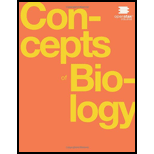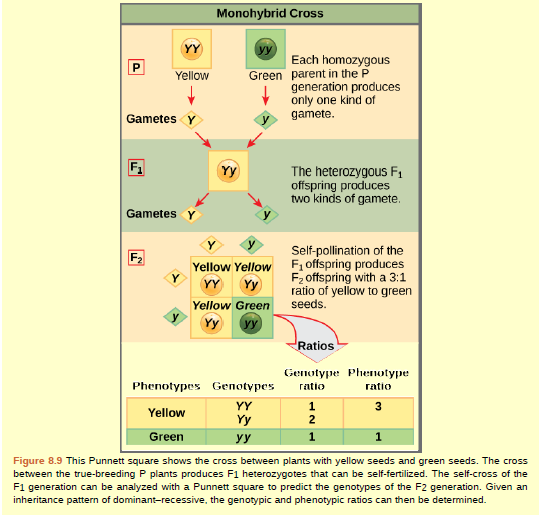
Concept explainers
Figure 8.9 In pea plants, round peas (R) are dominant to wrinkled peas (r). You do a test cross between a pea plant with wrinkled peas (genotype rr) and a plant of unknown genotype that has round peas. You end up with three plants, all which have round peas. From this data, can you tell if the parent plant is homozygous dominant or heterozygous?

To analyze:
If the parent plant is homozygous dominant or heterozygous.
Introduction:
An organism is known as homozygous dominant when it carries two copies of same dominant allele and when it carries two copies of the same recessive allele, then it is called as homozygous recessive. In case of heterozygous organisms, two different alleles of a gene are present.
Explanation of Solution
Given:

According to the figure, Punnet square depicts the cross between plants with yellow and green seeds. There is a cross between the true-breeding parent (P) plantswhich produce F1 heterozygotes and are capable of self-fertilization. This self-cross of the F1 generation can be used for analysis with the Punnet square for predicting the genotype of the F2 generation. If the inheritance pattern of the dominant and recessive is provided then, the genotypic and phenotypic ratios can be determined.
Here, the pea plants having round peas(R) are dominant to the wrinkled peas(r). A test cross between a pea plant with the wrinkled peas having genotype (rr) and an unknown genotype having round peas. The progenyhas three plants with round peas. From this data,it cannot be surely concluded if the given plant is homozygous or heterozygous because the data set given is quite small. Due to a random chance, the three plants have acquired the dominant gene only even if the recessive gene is present.
Thus,from this data, we can't conclude if the given plant is homozygous or heterozygous because the data set given is quite small.
Want to see more full solutions like this?
Chapter 8 Solutions
Concepts of Biology
Additional Science Textbook Solutions
College Physics
Biology: Life on Earth (11th Edition)
Human Anatomy & Physiology
Human Anatomy & Physiology (2nd Edition)
Human Physiology: An Integrated Approach (8th Edition)
Microbiology: An Introduction
- You want to determine whether genes a and b are linked. What cross would you use and why? How would this cross tell you if they are linked?arrow_forwardIn the video game Animal Crossing: New Horizons, flowering breeding is based in genetics. Each flower's color is determined by the genotype at three or four unlinked genes: R, Y, W, and S. The genotype of the elusive blue rose is RR YY ww ss. In the game, one way to get a blue rose is to cross two roses with the Rr Yy Ww ss genotype. A) What types of gametes and in what proportions will a Rr Yy Ww ss rose produce? B) In a cross Rr Yy Ww ss x Rr Yy Ww ss what are the possible offspring genotypes and at what frequency will they each appear? Show your work. C) What proportion of the offspring of the cross will be blue roses?arrow_forwardYou have a purple-flowered pea plant, but you do not know if it is homozygous (PP) or heterozygous (Pp) for flower color because both genotypes result in the same purple phenotype. Purple color allel (P) is dominant over white flower allel (p). What would you do to determine the genotype of flower color of this plant? Lötfen birini seçin: O a. Crossing the plant with homozygous large flowered pea plant (LL) Ob. Crossing the plant with heterozygous purple flowered pea plant (Pp) Crossing the plant with homozygous dominant purple flowered pea plant (PP) d. Crossing the plant with a plant whose genotype is unknown e. Crossing the plant with homozygous recessive white flowered pea plant (pp)arrow_forward
- Consider a dominant pure-breeding parent pea plant that had green peas, was tall, and had purple flowers, was crossed with a recessive pure-breeding parent that had yellow peas, was short, and had white flowers. In order to produce a gene map, Doja Cat selects a single F1 heterozygote offspring and test crosses it to produce 80 F2 offspring that collectively exhibit eight different phenotypes with 10 organisms of each phenotype. Can she automatically assume that the three genes in the pea plants were linked?arrow_forwardIn a test cross, peas of an unknown genotype are crossed with peas of a known genotype. In this example, smooth peas are the unknown and wrinkled peas are the known (rr). If half of the offspring from that cross are smooth and half are wrinkled, what is the genotype of the unknown plant?arrow_forwardImagine you are Performing a cross involving seed color in garden pea plants. What F1 offspring would you expect if you cross true-breeding parents with green seeds and yellow seeds? Yellow seed color is dominant over green.arrow_forward
- Figure 8.10 In pea plants, purple flowers (P) are dominant to white (p), and yellow peas (Y) are dominant to green (y). What are the possible genotypes and phenotypes for a cross between PpYY and ppYy pea plants? How many squares would you need to complete a Punnett square analysis of this cross?arrow_forwardIn pea plants yellow seed color, (GG) and round seed shape (WW) seeds are dominant traits, while green color or (gg) wrinkled shape (ww) seeds are recessive traits. You cross a pure breeding plant with yellow wrinkled seeds to a pure breeding plant with green round seeds to generate F1s. When you perform a reciprocal cross you get the same results. If you perform a test cross on a female from the F1 generation, what outcome do you expect in the offspring? a) 4 phenotypes in equal proportions b) 4 phenotypes in unequal proportions c) 2 phenotypes in equal proportions d) 8 phenotypes in unequal proportions e) None of the abovearrow_forwardA pea plant has a mendilian completely dominant gene for height flower colour phenotype. A pure breeding tall purple flower plant is crossed with a white dwarf plant. All offspring are purple and tall. If one of these offspring are crossed again with the white dwarf plant, what is the chances of producing a tall white flower? Explain your answer and any assumptions that you had to make. Note: You may not need the entire punnett square below or you may wish to use a different method.arrow_forward
- In Primula vulgaris (primrose), purple flowers are dominant to white flowers, and short plants are dominant to tall plants. The genes controlling these two traits are on different chromosomes. You cross a true-breeding purple, short plant with a true-breeding white, tall plant and then intercross the resulting F1 offspring. In the F2 offspring, you find the following phenotypes: Purple, short Purple, tall 608 161 White, short White, tall 173 58 With your knowledge of the x' test, you will determine whether the outcomes of the F1 intercross corresponds to expectations based on Mendelian genetics. 1. What is your null hypothesis for the outcome of the F1 intercross? Write it here: 2. Based on your null hypothesis, how many individuals do you expect in each of the phenotypic classes? Write your expectations below. Purple, short Purple, tall White, short White, tall 3. What are the degrees of freedom for this test? Write your answer here:arrow_forwardImagine you are crossing two plants that have these two genotypes—Tt and tt. What are the two genotypes of the gametes that the Tt plant can make? What is the one genotype of the gametes that the tt plant can make? Set up a Punnett square to analyze the cross. Does the Punnett square need to have four boxes or just two? If you were crossing a TT plant with a tt plant, how many boxes would be necessary in a Punnett square?arrow_forwardThree recessive traits in garden pea plants are as follows: yellow pods are recessive to green pods, bluish green seedlings are recessive to green seedlings, creeper (a plant that cannot stand up) is recessive to normal. A true breeding normal plant with green pods and green seedlings was crossed to a creeper with yellow pods and bluish green seedlings. The F1 plants were then crossed to creepers with yellow pods and bluish green seedlings. The following results were obtained for the F2 offspring: 2059 green pods, green seedlings, normal 151 green pods, green seedlings, creeper 281 green pods, bluish green seedlings, normal 15 green pods, bluish green seedlings, creeper 2041 yellow pods, bluish green seedlings, creeper 157 yellow pods, bluish green seedlings, normal 282 yellow pods, green seedlings, creeper 11 yellow pods green seedlings, normal Construct a genetic map that shows the…arrow_forward
 Concepts of BiologyBiologyISBN:9781938168116Author:Samantha Fowler, Rebecca Roush, James WisePublisher:OpenStax College
Concepts of BiologyBiologyISBN:9781938168116Author:Samantha Fowler, Rebecca Roush, James WisePublisher:OpenStax College Biology: The Dynamic Science (MindTap Course List)BiologyISBN:9781305389892Author:Peter J. Russell, Paul E. Hertz, Beverly McMillanPublisher:Cengage Learning
Biology: The Dynamic Science (MindTap Course List)BiologyISBN:9781305389892Author:Peter J. Russell, Paul E. Hertz, Beverly McMillanPublisher:Cengage Learning

